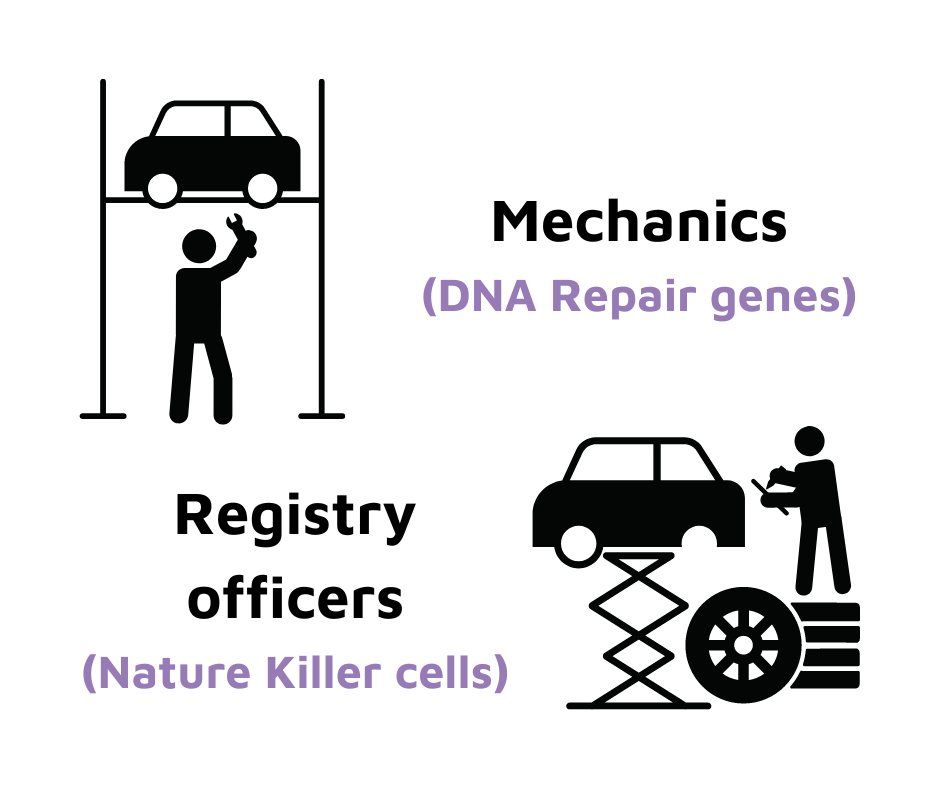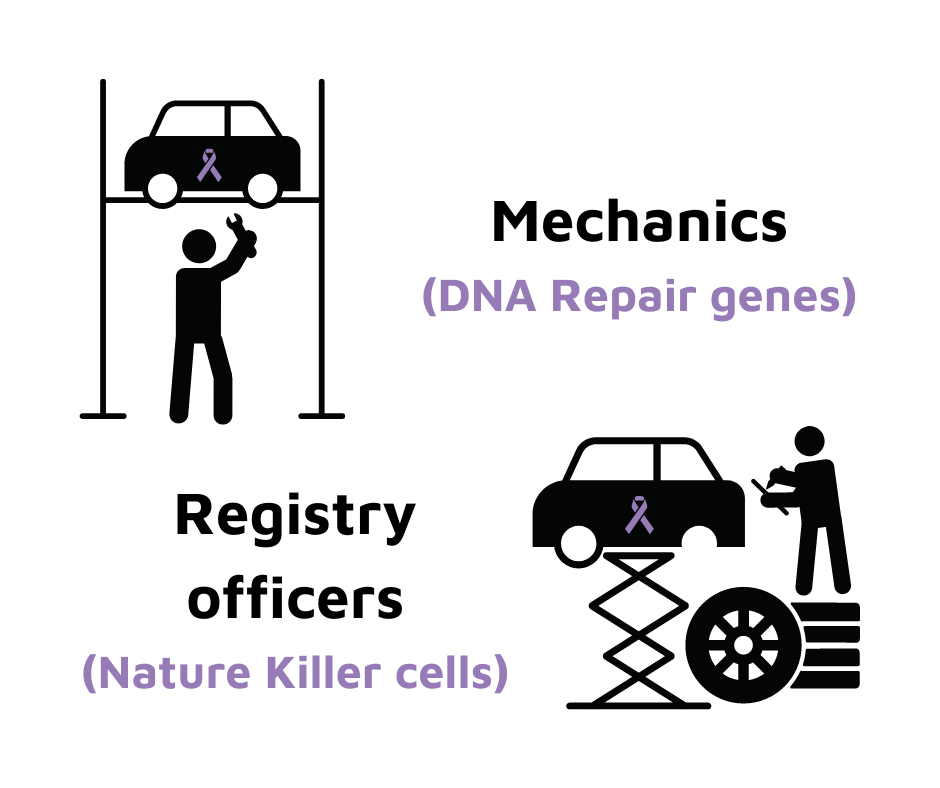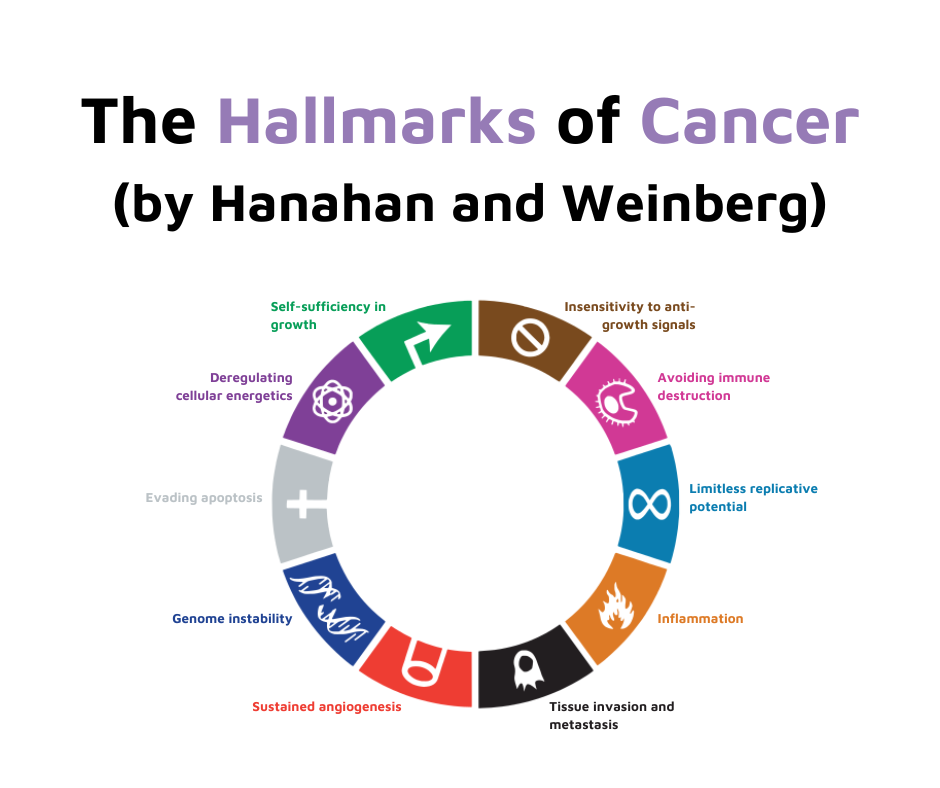I think most of the people who are reading this post know about the word “cancer”. But do you know what causes them?
Brief answer: Not sure, but related to genetic and environmental factors.
Now we go to the detailed answer.
When learning about Cancer Genetics, we usually used cars as metaphors.
Let's imagine your cell, the basic component of your body, is a car. The car has two very important engine-control accessories, which are the accelerator pedal and the brake pedal, used to adjust the speed of the car. Human cells also have some things similar. They grow and divide under moderation of the gene activators (accelerator pedal) and inhibitors (brake pedal), to make sure all of the genes are working at appropriate level, not too much, not lack of any. That’s the only way the cells can maintain the living without causing any disease or abnormal appearance (“phenotype”).
Then, what will happen to the body if one day, the genes decide to not work normally anymore?
Before going deeper into the metaphor, I would like to warn you that this one is super terrible and tragic, with respect to the ones who are suffering from cancers. Just…keep your mind stable, okay.
Assume that you’re a normal worker, and today is one of your workdays. You wake up, prepare everything you need, rush out to your car and drive to your workplace. Then, after going half way, suddenly, you feel like your car is going quite fast, faster than the speed you usually drive, and will pass the permitted speed very soon.
This is not the first time you have been in this situation, and you know you just need to release the accelerator pedal to slow the car down - but it does not work this time. The pedal is stuck, it will keep the car going at this speed, even faster. Freak out, you turn your foot to the brake pedal, use everything you have to push on it. Usually, the car will have a sudden stop with a force of inertia strong enough to hurl you out of your car if you don’t have a seat belt, but at least it will stop.
However, usually doesn’t mean all the time.
Today is the day when the luck goddess does not want to support you. Both your accelerator and brake pedals are broken, which means at the time you start this car, you cannot stop it anymore.
You desperately turn your steering wheel, try your best to not slam into any vehicles also on the roads while the car keeps accelerating. However, above all people, you must be the one who is aware the most that this is just prolonging your unavoided destiny. When the goddess finally decides to leave you, there will be an obstacle in front of you, and…
See, I have told you this is a terrible metaphor.
Fortunately, to avoid those tragedies, we have something called “vehicle registry”. After some time of working, you have to take your car to the Vietnam Registry to do a check up, to see if it can still be used or not. You also need to take your car in for regular maintenance (similar to your regular health check up), so the mechanics can repair it. Those registries and maintenance usually detect the “error” vehicles, stop them from continuing to join the traffic and endangering everyone.
However, again, usually doesn’t mean all the time.
If, if, both the mechanicians and the registry officers cannot detect the faulty parts for some reasons, those parts will become a real problem, which can lead to an accident like above. Different causes, but same result.
Now, after all of the Mechanical Engineering things, let’s return to the Medical Doctor world by replacing the terminologies.
Accelerator pedal = Oncogenes (the genes accelerate cell division)
Brake = Tumor suppressor genes (the genes which stop cell division before it going too far)

Mechanics = DNA Repair genes (the repairing genes of DNA errors)
Registry officers = Nature Killer (NK) cells (a lympho cell have the ability of killing error cells)

And finally, our protagonist today.
The accident = Cancer.

That’s the basis of cancer formation. Now, since my big boss has requested it, I’ll introduce to you the “Hallmarks of Cancer”, developed by Hanahan and Weinberg. The Hallmarks include 8 main and 2 enabling characteristics of a cancer cell. This is not difficult, but to make it easier for you to understand, I’ll show you a game I develop (in the form of words), called “Cancer car simulation”.

First, imagine you have a car in front of you. Just choose your favorite car, size and brand are variable, even non-existent is okay, because this is your imagination. Have you got it ready in your mind? Get in, please, I’ll sit on the front seat next to you. Lock your seat belt, push the brake pedal to start the engine, then check your seat and the wing mirrors, adjust them to make sure you feel comfortable while driving. Oh, but don’t release the handbrake yet, we don’t want the disaster to happen immediately. Your accelerator pedal is stuck (Self-sufficiency in growth) and your brake is broken (Insensitivity to anti-growth signals), remember?
Don’t panic, this is just a simulation. Keep calm, push the brake pedal, and put the handbrake off.
Congratulations, you have created a cancer cell.
Now, your car is starting to run, please turn the steering wheel to control it. Yes, you are doing good, let’s go to the vessels for bigger roads. Just drive, don’t worry, you know where you want to go…actually, you are likely to not know, because your car is a malignant tumor, which have the ability to go to other regions inside this body (Tissue invasion and metastasis), so the target location is not important.
We started for a few minutes. You are doing a very good job of controlling your car. Don’t stress yourself out, release and observe some scenes outside. You should enjoy this beautiful body now, because you won’t have this chance again.
Ah, they’re here already.
You see that car? It looks exactly like your car, isn’t it. The driver also looks like you, too. Of course, since that car is one of your replications, the result of a cell division happened a while ago, but I guess you’re too nervous to realize it. The normal cells also have this ability (except some), but they can only divide to a limited point before dying from a cell self-destroying (apoptosis) mechanism. Your car is different, it is not affected by both of them. In theory, you can drive forever, create unlimited replications (Limitless replicative potential), and, most importantly, cannot die from apoptosis (Evading apoptosis). So cool, right?
Another cool thing about your car is…maybe you already realize. We are driving very fast, but none of the lymphocyte (white blood cells) “policemen” step out to stop us. It’s because in their eyes, your car looks totally normal, so they won’t come to kill us like other pathogens (Avoiding immune destruction). “Agent” NK cells are another story, but in this simulation they are not appear yet.
Without any limitation, you have all the power to do whatever you want in this body. I hope that you have felt more confident, but in case you’re still nervous, I’ll give you some encouragement:
You don’t have the right to be scared anymore, because you have already made a huge mess outside.
During your reckless drive, the transportation system, or genome, is severely damaged (Genome instability). Accidents occur everywhere, the tissues at any place you went through are totally ruined, turn into a nest for bacterias made by dead white blood cells, swelling and hot as if there is a volcano there (Inflammation). The vessel walls collapse after being hitted by your car (yeah, you have hit like…a dozen of walls until now), creating new undesired roads for your car (Sustained angiogenesis). The transportation system is destroyed means the red blood cell cars with tons of nutritions and oxygen cannot travel normally. The delicious foods meant to be given to the normal cells now all belong to you and your “siblings”, and you guys can use it to grow unstoppably (Deregulating cellular energetics).
It’s fortunate that this is only a simulation, so you don’t have to take responsibility for this mess. But, please remember, this is what happens when a malignant tumor occurs inside a body, and in this world, there are millions of people who are suffering from it.
Return to the game. As I said before, in theory, you can play this game forever…unless your world collapses, or you are killed by some external factors. In other words, this simulation will reach its end when the body dies, or the doctors decide to step in.
There are 6 ways to treat cancer (until now, because the future will be different): Surgery, Chemotherapy, Radiation therapy, Hormone therapy, Immunotherapy, and Stem cell transplant.
Short explain: Your car can be destroyed by 6 ways: Cut by a sharp knife then throw out of the world; Melted into a puddle by tons of chemicals; Burned by radiation from the “sun”; Starved to death because your nutritions (host’s hormones) are blocked; Killed by the “heroes” that still crawling under your wheel just a minute before; and Replaced by healthy cells.
Tell me, among all of these, what is your favorite way to die?
Well, actually, choosing means nothing here, because the therapy depends on your host and their doctors. But you, with your tumor car, don’t have to worry. Remember I have said your car is a malignant tumor? You can just go to another organ to escape the therapy, then start to grow again. The only thing will be changed is your name, because the cancer is named based on the organ they developed in. In breast - Breast cancer; in liver - Liver cancer; in lung - Lung cancer (you can read this post to know more about some cancer’s name). Basically, they’re all cancer, but in different locations, and (maybe) by different causes.
*Ting ting*
Oh, we ended up on time. I’ll stop the car, you can get off now.
I hope you like this “Cancer car simulation” game. Please let us know your thoughts under the comment, so we can improve in our next game. Thank you very much for joining us. Hope that we can see each other again.
Sincerely,
VinUnians
Comments
Sign in or become a Sincerely, VinUnians member to join the conversation.
Just enter your email below to get a log in link.






